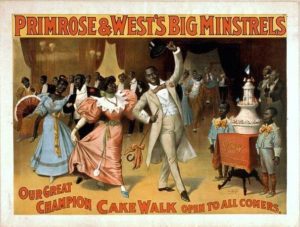Ragtime is an American genre that Is one of America’s jewels. The history of ragtime is just as vivacious as the music itself. Ragtime had a robust presence in musical composition and entertainment between 1895 to 1920, as its popularity rose. The genre is one that is unique, according to the Library of Congress, ragtime is defined as “a genre of musical composition for the piano, generally in duple meter and containing a highly syncopated treble lead over a rhythmically steady bass.” Ragtime has unique characteristics to other styles of music during this time; it’s exciting, vivacious tone came from syncopation which is the displacing of a beat from its assumed course meter. This sound could make people propulsion. Commonly black people learned how to play ragtime by ear, similarly to their African and Afro-Caribbean ancestors whom often used “head syncopation” with drumming and dancing.

an example of syncopation
Ragtime’s history has many different social implications, just like most music genres and styles, as time changes the way society perceives the art form changes; ragtime is the perfect example of this. Ragtime started Missouri, more specifically, St. Louis (the style of music was supposedly also in Mississippi at the time). There were multiple styles of ragtime as time passed. For most of the early 1900s, there was a distinct racial, social implication. For example, the cakewalk was a favorite rag up until 1904. Cakewalk could be considered “pre-ragtime” dance form, in which slaves would pair up dress up like their white masters (for the master’s entertainment of course) and dance around acting just like their masters. Whichever couple did the best would win a piece of cake? Another example would be the Coon Song, which was when white people in blackface would play the piano and sing racist songs. The Coon Song became known as the Ragtime Song, which was using that syncopation in vocals as opposed to playing them. As times changed in America, the style, connotation, and popularity of ragtime music began to change. Classic rag, which was the name for ragtime that had a Missouri style which is how Scott Joplin, known as the king of ragtime for writing 40 pieces of rag music.

An important figure in ragtime is James Scott, he is just as notable and has contributed as much as Scott Joplin and Joseph Lamb. Born from two slaves in southwestern Missouri. Scott’s musical abilities came from his mother who taught him and his five siblings how to play piano by ear. Since James Scott was isolated, living in southwestern Missouri, he had been disconnected from the other black cities. With the advances of the railroad, there was easy access to these predominantly black cities because of this nightlife had expanded making rag more popular. James Scott was greatly respected, his various professions included teaching music, directing church choirs and playing orchestras. His official career as a ragtime composer started in 1903, when he had gotten discovered Charles R. Dumars, his music had gotten many praises for being extremely catchy, and his sheet music began to be sold in major cities like Chicago and New York.
[embedyt] https://www.youtube.com/watch?v=q4PCF3qxNsk[/embedyt]
In conclusion, I greatly appreciate ragtime and its overall contribution to the music industry. Although ragtime has deep roots in racism, it’s vivacious energy makes it enjoyable to listen to. Something I had never realized is the way in which ragtime was learned. The technique of learning by ear was one that our ancestors had always possessed seen through the beating of African drums or the syncopation of Afro-Caribbean dances.

